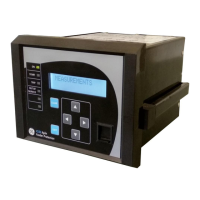where;
t: Operation time
K: Constant (see the table)
I: Measured current
Is: Current threshold setting
α: Constant (see the table)
L: ANSI/IEEE constant (zero for IEC curve)
T: Time multiplier setting (TMS) for IEC curves or Time dial setting (TD) for IEEE curves
Define Time DT - - 0
Very Inverse IEC 13.5 1 0
Extremely inverse IEC 80 2 0
Long Time Inverse UK 120 1 0
Moderate Inverse IEEE 0.0515 0.02 0.114
US Inverse CO8 5.95 2 0.18
US Short Time Inverse CO2 0.02394 0.02 0.01694
2.1.2 Principle of Protection Function Implementation
An energising quantity is a current input from a system current transformer or another quantity derived
from the current input. The energising quantities are extracted from the power system and presented
to the IED in the form of analogue signals. These analogue signals are then converted to digital
quantities where they can be processed by the IEDs internal processor.
In general, an energising quantity is compared with a threshold value, which may be settable or hard-
coded depending on the function. If the quantity exceeds (for overvalues) or falls short of (for
undervalues) the threshold, a signal is produced, which when gated with the various inhibit and
blocking functions becomes the Start signal for that protection function. This Start signal is generally
made available to Fixed Scheme logic for further processing. It is also passed through a timer function
to produce the Trip signal. The timer function may be an IDMT curve, or a Definite Time delay,
depending on the function. The timer can be configured by a range of settings to define such
parameters as the type of curve, The Time Multiplier Setting, the IDMT constants and Definite Time
delay.
In P153 there are several independent stages for each of the functions. All the stages (1, 2 and 3) can
be set for DT/IDMT timer function. If the DT time delay is set to '0', then the function is known to be
"instantaneous". In many instances the term “instantaneous protection” is used loosely to describe
Definite Time protection stages even when the stage may not theoretically be instantaneous.
2.1.3 Timer Hold Facility/Reset Characteristics
This feature may be useful in certain applications, such as when grading with upstream
electromechanical overcurrent relays, which have inherent reset time delays. If you set the hold timer
to a value other than zero, the resetting of the protection element timers will be delayed for this period.
This allows the element to behave in a similar way to an electromechanical relay. If you set the hold
timer to zero, the overcurrent timer for that stage will reset instantaneously as soon as the current falls
below a specified percentage of the current setting (typically 95%).

